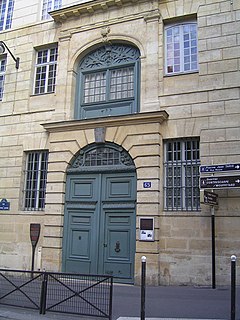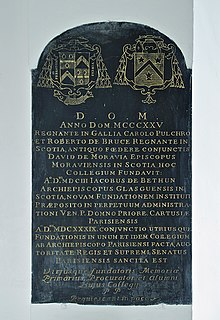| |||||
| Centuries: | |||||
|---|---|---|---|---|---|
| Decades: | |||||
| See also: | List of years in Scotland Timeline of Scottish history 1326 in: England • Elsewhere | ||||
Events from the year 1326 in the Kingdom of Scotland .
| |||||
| Centuries: | |||||
|---|---|---|---|---|---|
| Decades: | |||||
| See also: | List of years in Scotland Timeline of Scottish history 1326 in: England • Elsewhere | ||||
Events from the year 1326 in the Kingdom of Scotland .
Year 1332 (MCCCXXXII) was a leap year starting on Wednesday of the Julian calendar.
Year 1337 (MCCCXXXVII) was a common year starting on Wednesday of the Julian calendar.

Holyrood Abbey is a ruined abbey of the Canons Regular in Edinburgh, Scotland. The abbey was founded in 1128 by David I of Scotland. During the 15th century, the abbey guesthouse was developed into a royal residence, and after the Scottish Reformation the Palace of Holyroodhouse was expanded further. The abbey church was used as a parish church until the 17th century, and has been ruined since the 18th century. The remaining walls of the abbey lie adjacent to the palace, at the eastern end of Edinburgh's Royal Mile. The site of the abbey is protected as a scheduled monument.
The Treaty of Edinburgh–Northampton was a peace treaty signed in 1328 between the Kingdoms of England and Scotland. It brought an end to the First War of Scottish Independence, which had begun with the English party of Scotland in 1296. The treaty was signed in Edinburgh by Robert the Bruce, King of Scots, on 17 March 1328, and was ratified by the Scottish Parliament at Northampton on 1 May.
The Treaty of Corbeil (1326) renewed the Auld Alliance between France and Scotland. It confirmed the obligation of each state to join the other in declaring war if either was attacked by England. The deputation (delegation) from Scotland was led by Thomas Randolph, 1st Earl of Moray.
James Bane was Bishop of St. Andrews for a brief period in the early 14th century. In his earlier career, James had been a canon of Aberdeen and prebendary of Cruden.
The Abbot of Kelso was the head of the Tironensian monastic community at Kelso Abbey in the Scottish Borders. The Abbey was originally founded at Selkirk in 1113 by David, Prince of the Cumbrians, and thus the first three Abbots were Abbot of Selkirk. It was moved to Kelso by David and John, Bishop of Glasgow in 1127. The abbot was the first in Scotland to be granted the mitre in 1165. In the 16th century the monastery increasingly came under secular control, and finally in 1607 it was granted as a secular lordship (Holydean) to its last commendator, Robert Ker of Cesford, later Earl of Roxburghe. The following is a list of abbots and commendators:

The Scots College was a college of the University of Paris, France, founded by an Act of the Parliament of Paris on 8 July 1333. The act was a ratification of an event that had already taken place, the founding of the Collegium Scoticum, one of a number of national colleges into which the University was divided. The Scots College came to an end in 1793 when the National Convention abolished the colleges and reorganized the University along different lines.

David de Moravia was Bishop of Moray during most of the First War of Scottish Independence. He was elected Bishop of Moray, probably in early 1299. Extended details exist regarding the election because of an extant letter of Pope Boniface VIII. The result of the election was that David had 13 votes, the Dean had 4 votes, the Chancellor had 3 votes and the Archdeacon 1 vote. The Dean declared that David was elected, and sent a request for confirmation to the Papacy. The latter found an irregularity, though what exactly this was not revealed. The election result was nominally declared void, but the Pope himself provided David directly to the bishopric. He was consecrated as bishop at Anagni in Italy on 28 June 1299, by Matthew of Aquasparta, Cardinal-Bishop of Porto.
John de Pilmuir [Pilmor, Pylmore] was a 14th-century prelate based in Scotland. He was probably the son of Adam de Pilmuir, a Dundee burgess, and the brother of Richard de Pilmuir, Bishop of Dunkeld (1337/38–1345/47).
Sir David II Strathbogie was Earl of Atholl, Constable of Scotland, and Chief Warden of Northumberland.
Maxton is a hamlet and civil parish in Roxburghshire, Scotland, and part of the Scottish Borders region.

The Auld Alliance is an alliance made in 1295 between the kingdoms of Scotland and France against England. The Scots word auld, meaning old, has become a partly affectionate term for the long-lasting association between the two countries. Although the alliance was never formally revoked, it is considered by some to have ended with the signing of the Treaty of Edinburgh in 1560. For others it survives today.
The Sheriff of Argyll was historically a royal officer charged with enforcing the king's rights in Argyll; in Scotland, the concept of sheriff gradually evolved into a judicial position.
Sir Andrew Murray (1298–1338), also known as Sir Andrew Moray, or Sir Andrew de Moray, was a Scottish military and political leader who supported David II of Scotland against Edward Balliol and King Edward III of England during the so-called Second War of Scottish Independence. He held the lordships of Avoch and Petty in north Scotland, and Bothwell in west-central Scotland. In 1326 he married Christina Bruce, a sister of King Robert I of Scotland. Murray was twice chosen as Guardian of Scotland, first in 1332, and again from 1335 on his return to Scotland after his release from captivity in England. He held the guardianship until his death in 1338.

Richard Óg de Burgh, 2nd Earl of Ulster and 3rd Baron of Connaught, called The Red Earl, was one of the most powerful Irish nobles of the late 13th and early 14th centuries.
John Walwayn was an English royal official and scholar, and a proposed author of the chronicle known as Vita Edwardi Secundi a partial record of the reign of Edward II.
The Sheriff of Dumbarton was historically the royal official responsible for enforcing law and order in Dumbarton, Scotland and bringing criminals to justice. Prior to 1748 most sheriffdoms were held on a hereditary basis. From that date, following the Jacobite uprising of 1745, the hereditary sheriffs were replaced by salaried sheriff-deputes, qualified advocates who were members of the Scottish Bar.

NGC 1326 is a lenticular galaxy in the constellation Fornax, 63 million light-years away. It was discovered by English astronomer John Herschel on 29 November 1837. It is a member of Fornax Cluster, a NGC 1316 subgroup and has a diameter of 70 000 light-years.
The Exchequer Rolls of Scotland are records of the Scottish Exchequer dating from 1326 to 1708. The accounts were the responsibility of the Comptroller of Scotland. The National Records of Scotland also has corresponding precepts and receipts for some comptrollery accounts, known as "vouchers".